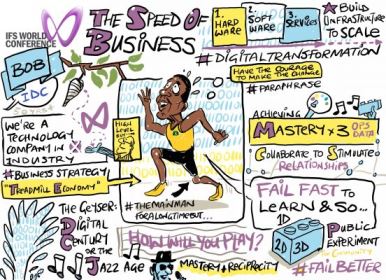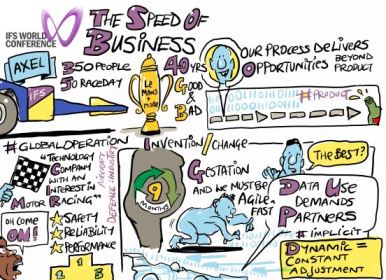“Digital transformation is not providing a downloadable PDF,” commented Jon Briggs. And then he introduced a man who knows exactly what it is.
Bob Parker
Group Vice President, IDC
IDC has been tracking technology and how people use it for over 50 years.

There are two common questions I get about digital transformation:
- Is it just hype?
A valid question – I’ve seen lots of terms come and go without leaving much impact. There’s a rule of thumb: if you need one more thing to go in a report add “get executive sponsorship” because it’s never wrong. With that in mind, I went looking for what CEOs are saying about it, and they are gung-ho. And, they’re making it a business strategy. We’re in a treadmill economy – lackluster growth – so we’ve gotten good at keeping profit margins high and sitting on piles of cash. They use it to prop up the stock price but there’s no real growth in that. So where’s the growth? Warren Buffet said that “data is the new oil.” Oil enabled an output focused economy. This time, it’ll be on the input end. What if we could reduce the costs of healthcare by 50%? But it’s not about conveniences for the buyer, it’s about the experience. You have to become a jazz musician playing 3,000 chords for three people, not a rock star playing three chords for 30,000 people. - What does it mean?
Our definition has to include true transformation. Not just changes to the way we do the things we do now, but whole new capabilities for the business, including decision making.
Mastery of relationships (or experiences)
The first platform was reach. The second platform was relevancy. Now, we’re talking reciprocity. Lego is a great example of a company that’s been having this conversation. It goes back to the Mindstorm product, which hackers started customizing. The first reaction was “call the lawyers” but then the CEO said, “wait, what if we let them do it?” and that started the conversation with the customers. But then Fusion was a failure. Children don’t have the patience to build a stop motion movie. Why mention failure? This conversation requires the courage to fail in public.
Creating the experience promise doesn’t mean a thing if the backend systems can’t deliver on it.
Mastery of operations
This trio is scale to scope to speed.
Tim Cook was VP of operations at Apple before he took over, and he understood the value of speed in adapting the business and the supply chain. It was a huge part of Apple’s success. Local Motors designed and built a 3D printed car pattern in less than a year. It won’t pass road legislation but it was a huge achievement in an industry that typically takes four times that. Engineers typically respond well to these community contributions, because they thrive on the conversation about their products.
Mastery of Information
Syntax – Semantics – Socialization
Schindler did a project where they put sensors in elevator cars and used location services in their servicing. But it’s what they did afterward that was much more impressive. They realized that they had information on how billions of people move through cities. They bundled it up and started selling it to cities and urban planners.
Most organizations are still just starting this journey. 64% of organizations are what we term ‘digital explorers’ or ‘digital players’. Only 22% are transformers or disrupters. There are barriers – technological and cultural – to move through each stage. Still, 3rd platform spending is growing with double digit growth, while second platform spending is shrinking.
Line of business is going to lead here, with board sponsorship. IT, you’re going to have to partner with the line of business to get this done.
There are three architectural constructs:
- Modernize
Over five years a modernization process can spend 30% less, and get 50% more done. You have to keep your core systems up to date – it’s worth it. - Build
This is where the money goes. You have to build digital models of your businesses. You have to “DVR” those processes, rewind them to analyze, and fast forwards to predict what happens next. - Monetize
Imagine if there was an industry cloud for architects or city planners – if I have people movement data, that’s my sales channel. That’s how industry clouds can enable monetization.
So here’s some advice for a CIO:
- Build infrastructure at scale
- Create integration with other systems, around microservices
- Provide resources to support insight – there might not be enough data scientists to live within the lines of businesses
- Interfaces become hugely important – agile methodologies, and physical and data security
- And make sourcing a key competency – you need to know how to deals with public clouds
One final thought:
My daughter does equestrian eventing. There you have to:
- Know the course
- Trust the course
- Have the courage to make the jump.
In digital transformation:
- Know the technology
- Trust the strategy
- Have the courage to make the leap
Axel Kruse
Operations Director, Sauber Formula 1 team

Our race team? 50 or 60 people at the track and two drivers. We have 350 people in Switzerland as well. And we’re a small team in Formula 1. We’ve come a long way. What does that mean?
Well, we’ve done more than 40 years in Formula 1 and we’ve been world championships in many other races. We won the 24 hours of Le Mans and the World Sports Prototype Championship. We’ve had good times and we’ve bad times. In the good times, you have to be prepared for the bad ones. Have a plan B. But just as important is to tell people in the bad times to be ready for the good times. We got the chance with BMW and we have the chance again with Longbow Finance.
We have employees from 28 countries – Formula 1 is not at all localized. We are a technology company with customers and technology partners. Formula 1 is a marketing platform. It’s one of the most important ones – it reaches a lot of people. It has a similar reach to the Olympic Games every year! We have 119 broadcast stations, reaching about 515 million people worldwide (roughly the population of Europe).
The complicated simple car
Now the car. On one side, yeah, it’s complicated. On the other, it’s really simple. We don’t have to worry about a range of temperature conditions. We don’t have to worry about driver comfort. If he has a good argument like being cozy makes him faster, I’ll listen. Otherwise, I don’t care. In fact, we only care about performance, safety and reliability.
Yes, we will lose cars. There will be crashes. But if you’re making mistakes and have a 10% scrap rate, you should be polishing your CV. So that leaves performance, which everyone is focusing on. We have to be fast and that is so difficult when everyone is doing it. Our product lifecycle is nine months. We have to relentlessly move forwards.
Every race is different. In theory, you want a different car for every race. You want different aero parts for the different tracks to make the most of the chances to build speed, on the straight or otherwise. The time of one car for the whole season is over. We need the systems to manage that and have the car changes ready in time. We need tight processes and work fast. And because we’re small, we need to work smart. We cannot afford to try multiple versions.
Model, model and model again
The most important thing is the aerodynamics. More downforce on the car, with less drag. And we use Computation Fluid Dynamic to model it. Then you build a 60% model and put it in the wind tunnel. And then you test on the track. We cover the cars with sensors to gather data. The aerodynamic work never stops – and it will never stop.
We model fuel tank slosh. The more fuel in the car, the slower you are. We could go lower than the fuel we take now but there must be enough left at the end of the race for testing.
We have such good competitors that I am so happy to have such strong partners like IFS that can do things we need better than us.
Without data, F1 wold not be the same. But it re-informs our industry partners. BMW learned from our carbon cage for the drivers. They learned how to check for damage and repair it. In F1 we can chuck it away. You can’t for a €120,000 that’s had a crash. So, yes, we have the F1 car as the final product, but we are also creating things for the aerospace industry, for the car industry and even for the health industry. We’ve just milled a titanium backbone piece.